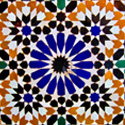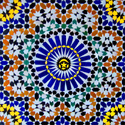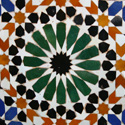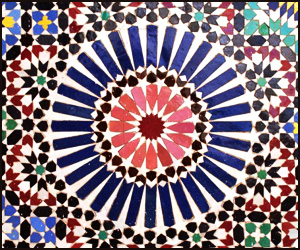Mathematics

|
Of
all Islamic sciences, mathematics has been best served by
scholarship, most particularly in the recent decades.[1]
Kennedy offers a good survey of the mathematical sciences in
Islam.[2]
Yet despite this, its due place is not adequately recognised,
and only a work of vast proportions, a sort of encyclopaedia of
Islamic mathematics, written by those who excel at mathematics,
Arabic, Islamic history, and the history of mathematics, could
do it justice. Muslim mathematics, like other sciences, has also
been a victim of the usual historical distortions, which
misattribute, or suppress many of its accomplishments, or demean
its importance. The following outline aims at raising some such
problems. However, as with all other issues addressed in this
work, this author does not have the competence, nor the space,
to address all matters as adequately as wished. Others in the
future will have to pursue the task.
First and foremost, it is important to consider again the issue
of the true scale of the Greek legacy on Islamic mathematics.
The Greek legacy is decisive in one area, geometry, but is
minimal or non-existent in others. It is, however, common for
many historians of sciences to widen the impact in one area
(geometry) to the whole science of mathematics (just as Islamic
mapping relying on aspects of Greek mapping is turned into
plagiarism of Greek geography by Muslims). A worse error,
however, is the widely held view that nothing happened in the
medieval period. O’Connor and Robertson comment on this:
‘There is a widely held view that, after a brilliant period for
mathematics when the Greeks laid the foundations for modern
mathematics, there was a period of stagnation before the
Europeans took over where the Greeks left off at the beginning
of the sixteenth century. The common perception of the period of
1000 years or so between the ancient Greeks and the European
Renaissance is that little happened in the world of mathematics
except that some Arabic translations of Greek texts were made
which preserved the Greek learning so that it was available to
the Europeans at the beginning of the sixteenth century.’
The
authors go on saying:
‘That such views should be generally held is of no surprise.
Many leading historians of mathematics have contributed to the
perception by either omitting any mention of Arabic/Islamic
mathematics in the historical development of the subject or with
statements such as that made by Duhem that: ‘Arabic science only
reproduced the teachings received from Greek science.’[3]
Rashed also notes how it has been frequently affirmed since
Condorcet and
Montucla up to Borbaki, by way of Nesselman, Zeuthen, Tannery
and Klein (to cite only a few), that Classical algebra, for
instance, is the work of the Italian School perfected by Viete
and Descartes.[4]
Did not Milhaud (1921) and Dieudonne (1974) trace the early
history of Algebraic geometry back to Descartes?
[5] The modern
mathematician’s text is, in this respect, significant: between
the Greek prehistory of algebraic geometry and Descartes,
Dieudonne finds only a void, which ‘far from being frightening,
is ideologically reassuring.’[6]
These views are false on two essential grounds:
First, Muslim mathematics was superior in every possible respect
to its Greek counterpart, Muslim mathematicians adding a vast
new array of findings, and developments to the science.
Secondly, many mathematical accomplishments, thought to be of
Western origin, are in fact, of Islamic origin.
On
the first point, any comparative work between Greek and Muslim
mathematics will prove the immense superiority of Islamic
mathematics. Indeed, the medieval period, and the period between
the mid 10th and mid 11th century, in
particular, as noted by Berggren, was a highly creative period
for many of the mathematical disciplines in Islam, that saw
significant advances in arithmetic and algebra, the development
of spherical trigonometry, and brilliant contributions to
mechanics, optics, and cartography.[7]
This is highlighted by a few instances here. Suter, who studied
Islamic mathematics in good detail, could write:
‘In
the application of arithmetic and algebra to geometry, and
conversely in the solution of algebraic problems by geometrical
means, the Arabs far surpassed the Greeks and the Hindus.’[8]
The
most famous contributions to this field were Ibrahim Ibn Sina
n’s
(908-946) writings on the quadrature and the parabola, Abu
Al-Wafa’s (b.940-d. 997-8) writings on the construction of
regular polygons involving cubic equations, and Abu Kamil’s
(850-930) writings on the pentagon and the decagon.[9]
Another example is of the depth of the mathematical tradition in
mechanics as to be found in the correspondence between al-Kuhi
(940-1000) and al-Sabi (fl. 10th century), part of
which is summarised and studied by Sesiano.[10]
This correspondence is an example of serious work in Arabic on
the determination of centres of gravity, which goes considerably
beyond the work of Archimedes, and which contains discussions of
interest for geometry and the philosophy of mathematics.[11]
Rigour and ascertaining findings with precision was, as noted
with previous sciences, a real demarcation line between Islamic
and Greek science, and Berggren notes how in the 10th
century there was a decided tightening of rigour in Islamic
geometry, with the result that methods that had seemed perfectly
acceptable to Archimedes were seen as needing further
explanation.[12]
Islamic mathematics, as will be amply discussed in the
appropriate heading further on, above all, dwelt on practical
problems in a way Greek mathematics never did.
In
relation to the second point, as Islamic mathematics is examined
more thoroughly, most particularly due to the works of scholars
such as Djebbar, Rashed, Berggren, Saidan, etc, it comes to be
realised that many former accomplishments thought to be Western,
in fact, date from centuries earlier, back to the Islamic
period. Recent research, as O’Connor and Robertson insist, is,
indeed:
‘Painting a very different picture of the debt owed to Islamic
mathematics.. that modern mathematics is closer to Muslim
mathematics than the Greek,… many of the ideas which were
previously thought to have been brilliant new conceptions of
European mathematicians of the sixteenth, seventeenth and
eighteenth centuries are now known to have been developed by
Islamic mathematicians centuries earlier.’[13]
O’Connor and Robertson provide a good outline of the main
Islamic mathematicians and their works to prove the point.[14]
The
same point was also made by Berggren, who insists on the
mathematical autonomy and originality of Islamic civilisation,
and how innovations in arithmetic and algebra that once seemed
due to outside influence have emerged as integral parts of the
corpus of Islamic mathematics.[15]
Rashed, most particularly, gives instances, of how Muslim
mathematicians of the 11th-12th centuries
achieved results still incorrectly attributed to mathematicians
of the 15th-16th centuries, for, instance,
the method attributed to Viete for the resolution of numerical
equations; the method ascribed to Ruffini-Horner; general method
of approximation, in particular the one Whiteside designated as
the Al-Kashi-Newton method, and lastly the theory of decimal
fractions.[16]
In addition to methods which were to be reiterative and capable
of leading to in a recursive way to approximation, 11th
and 12th century Muslim mathematicians also
formulated new procedures of demonstration such as mathematical
induction still found in the 17th century.[17]
Similarly, they engaged in new logico-philosophical-debate: for
example, the classification of algebraic propositions and the
status of algebra in relation to geometry. It was their
successors who were to tackle the problem of symbolism.[18]
All of this is to say, Rashed concludes, that certain concepts,
methods and results attributed to Chuquet, Stifel, Faulhaber,
Scheubel, Viete, Stevin, etc, were actually the work of this
tradition of al-Karaji’s (953-1029) school, known furthermore to
the Latin
and Hebrew
mathematicians.[19]
Recent research, such as by Rashed himself and Djebbar, Berggren
dates,[20]
has also shown that the study of number theory formed a
continuous tradition and led to the discovery of theorems or
problems usually ascribed to Western mathematicians several
centuries later, such as the appearance of ‘Wilson’s’ theorem in
the work of Ibn al-Haytham, ‘Bachet’s problem of the weights in
al-Khazini (fl.1115-1130), or the summation of the fourth powers
of the integrers 1,2…., n in the work of the 10th
century mathematician al-Qabisi.[21]
In
geometry, the Muslim pioneering role is noted by Yushkevitch,
who observes how the birth of the theory of construction using a
compass with only one opening was due to Abu Al-Wafa (940-998),
a study of the problem only beginning in the time of the
European ‘Renaissance.’[22]
The theory of parallels was undertaken by al-Gauhari (ca
800-860), and followed up by Thabit Ibn Qurra (826-901), Ibn
al-Haytham, Omar
Khayyam
(1048-1131), and
others. The Muslims put forward ideas which were later developed
by Saccheri and Lambert, and in fact the first propositions of
non-Euclidian geometry dates from this time.[23]
This
previous misattribution of modern mathematics to the Greeks, and
to post ‘Renaissance’, modern Western scholars, just as other
accomplishments are also wrongly attributed to them, had a
particular colonial purpose. Joseph makes excellent comments on
this, how such Eurocentric scholarship aimed at devaluing the
contribution of the people under Western colonial rule so as to
ease their subjugation and domination.[24]
The classical Eurocentric trajectory, as he calls it,
deliberately passes scientific knowledge from the Greeks into a
period of Dark ages, then a re-discovery of Greek learning
leading to the Renaissance, itself leading to European hegemony
over cultural dependencies.[25]
One such Eurocentric ‘scholar’, highly in vogue in Western
history of science, Tannery, recalls that:
‘The
more one examines the Hindu and Arabic scholars, the more they
appear dependent upon the Greeks….. (and) quite inferior to
their predecessors in all respects.’[26]
The same ‘historian’
also notes how Muslim algebra, for instance, ‘in no way
superseded the level attained by Diophantus.’[27]
Demeaning the contribution of colonised people, generally the
Muslims, was used to justify the colonial argument that the
Westerner had taken over their country so as to civilise them,
because, they (the Muslims) have an inferior civilisation.[28]
The
colonial argument was not alone in demeaning the Islamic role,
though. As will be amply expanded in the final part of this
work, hostility to Islam and thence to its civilisation date
from the medieval period, and went on throughout the centuries,
the argument remaining the same, only the form altering with
time. The Muslim achievements such as in mathematics during the
medieval period were, thus, deemed the work of the devil, and
Muslim mathematics taken north of the
It
is certain that the Muslims, in mathematics, as in other
sciences, relied on other traditions, the Chinese, above all,
and also the Hindu and pre-Islamic cultures of the region. Hill,
however, notes that Muslim
mathematicians, in general, felt free to investigate aspects of
the subject that appealed to their tastes and met their
requirements and to pursue their investigations in any way they
chose.[31]
They did not feel constrained to use any particular method of
approach; no method was considered so superior to all others
that it became dominant. Hill pointed to al-Karaji (fl 11th
century), for instance, who totally neglected Indian
mathematics.[32]
Yushkevitch maintains that in the case where Chinese and Indian
scientists gave only a few rules for calculation, the Islamic
mathematicians completed scientific theories.[33]
Compared with the works of Indian and Chinese scientists, Muslim
mathematical works were more systematic, more complete, and
distinguished by the greater use of proofs, even in books of a
purely practical character.[34]
Other civilisations provided the means, but the real force
behind Muslim mathematics,
as with the rest of the sciences and accomplishments in
civilisation,
remains the faith itself.[35]
Islamic practice demanded precise calculations in inheritance
matters, commercial transactions etc.[36]
Arithmetic (al-hisab) was, as Ibn Khaldun
observes in his
Prolegomena, the first of the mathematical sciences to be used
by the Muslims, being a means of solving such material problems
that present themselves in daily life as assessment of taxes,
reckoning of legal compensation, and division of inheritances
according to Qur’anic law.[37]
Al-Baghdadi’s Takmila, for instance, contains an example
of arithmetical problems arising from Muslim religious
requirements, namely the calculation of the community’s share of
personal wealth: the zakat.[38]
The surveys in the Encyclopaedia of Islam under the
headings ‘Mirat’ (Inheritance) and ‘Faraid’
(Obligations) contain the basic stipulations of Islamic law on
the topic.[39]
Al-Khwarizmi
also says in the opening
flourish of his book on equations:
‘Numbers and shapes which man must understand thanks to the
beneficence of God the creator who has bestowed upon man the
power to discover the significance of numbers.'[40]
The
Islamic impact is also seized on by Wickens, who observes that:
‘Mathematics is par excellence the great field of pure theory,
of elegant and economical demonstration in the abstract,' all so
close to Islam’s view ‘of the rational recognition of beauty in
the ordering of things.'[41]
Arabic, equally, played its part. Arabic, Arnaldez and Massignon
observe, by facilitating ‘the interiorisation of thought, is
particularly suited to expressing exact scientific concepts and
to developing them, in much the same way as mathematical
concepts have evolved historically.’[42]
Stock, too, notes that Arabic is ‘inherently a good language for
expressing scientific constructions-a fact of considerable
importance for mathematisation.'[43]
The
following outline serves to reinforce most of the points just
made, especially with regard to the originality of Islamic
mathematics, its pioneering aspects, and how it impacted on the
Christian West and modern mathematics.
[1]
See for instance:
-J.L. Berggren: History of Mathematics in the Islamic
World: The Present State of the Art.
-J.L.Berggren: Mathematics and Her Sisters in Medieval
Islam: A Selective Review of Work Done from 1985 to
1995. Historia Mathematica 24 (1997), pp. 407-40.
-J.L. Berggren: Episodes in the Mathematics of
Medieval Islam (Springer, 1986).
-K.Jaouiche: La Théorie des parallèles en pays
d'Islam (Paris;Vrin, 1986).
-D. Lamrabet: Introduction à l'histoire des
mathématiques maghrébines (Rabat, 1994).
-R. Lorch: Arabic Mathematical Science (Variorum,
Aldershot, 1995).
-R.Rashed: Les Mathématiques infinitésimales du IXe
au XIe
siècles. 2 vols (Al-Furqan; London; 1993-96).
-R.Rashed: Géométrie et Dioptrique au Xe siècle: Ibn
Sahl, al-Quhi et Ibn al-Haytham (Paris: Les Belles
Lettres, 1993).
-B. Rosenfeld and G.P.Matvievskaya: Matematiki i
astronomi musulmanskogo srednevekovya i ikh trudi
(VII-XVII vv), 3 vols (Moscow: Nauk, 1983).
-F. Sezgin: Geschichte des arabischen Schrifttums
(Leiden: E.J. Brill, 1967-).
-H. Suter: Die Mathematiker und Astronomen der Araber;
op cit;
-F.Woepcke: Traduction du traité d'arithmétique d'Aboul
Haçan Ali Ben Mohammad Alkalçadi. Atti dell'Accademia
Pontificia dei Nuovi Lincei 12 (1858-9), pp. 230-75.
-A. Youschkevitch: Les Mathématiques arabes
(VIIe-XVe
siècles), (Paris: J. Vrin, 1976).
-S.Zeki: A History of Arabic Mathematics: 2 Vols
(
[2]
E.S. Kennedy: The Arabic Heritage in the Exact Sciences;
Al-Abhath; vol 23; pp. 327-44.
E.S. Kennedy et al: Studies in the Islamic Exact
Sciences; The American University of
[3]
John J O'Connor and Edmund F Robertson:
Arabic Mathematics;
op cit.
[4]
R. Rashed: The Development of Arabic Mathematics:
Between Arithmetic and Algebra
;
Tr. A.F.W. Armstrong (Kluwer Academic Publishers;
Dordrecht;
1994), p.339.
[5]
Ibid.
[6]
Ibid.
[7]
J.L. Berggren: History of Mathematics in the Islamic
World: The Present State of the Art.
[8]
Quoted in
R. Arnaldez-L.Massignon: Arabic Science; in Ancient
and Medieval Science; ed by R. Taton (Thames and
Hudson; London; English tr; 1963), pp. 385-421. at p.
408.
[9]
Ibid.
[10]
J. Sesiano: Note sur trois theorems de la mecanique d’Al
Quhi et elur consequence; Centaurus; 22; (1979);
pp. 281-97.
[11]
J.L. Berggren: The Correspondence of Abu Sahl al-Kuhi
and Abu ishaq al-Sabi; said to appear in Journal for
the History of Arabic Science; see J.L. Berggren:
History of Mathematics; op cit; p. 27; note 16.
[12]
J.L. Berggren: History of Mathematics in the Islamic
World; op cit; p. 23.
[13]
John J O'Connor and Edmund F Robertson:
Arabic Mathematics;
op cit.
[14]
Ibid.
[15]
J.L. Berggren: History of Mathematics; op cit; p. 27.
[16]
R. Rashed: The Development of Arabic Mathematics;
op cit; p.341.
[17]
Ibid.
[18]
Ibid; pp.341-2.
[19]
Ibid; p.342.
[20]
J.L. Berggren: History of Mathematics in the Islamic
World; op cit; p. 11.
[21]
See for this A. Anbouba: Un Memoire d’al-qabisi sur
certaines summations numeriques. Journal for the
History of Arabic Science; 6; pp. 208-81.
[22]
A.P. Yushkevitch: Commentary; in Scientific Change;
edited by A.C. Crombie (Heinemann; London; 1963),
p. 299.
[23]
Ibid.
[24]
G.G. Joseph: The Crest of the Peacock (Penguin
Books; 1991), at p 4.
[25]
Ibid.
[26]
Tannery ; 1887;
p. 6: in. R. Rashed: The Development of Arabic
Mathematics:
Between Arithmetic and Algebra
;
Tr. A.F.W. Armstrong (Kluwer Academic Publishers;
Dordrecht;
1994), p.338.
[27]
Tannery ; 1887;
p. 5: in. R. Rashed: p.339.
[28]
On the Western argument for colonization in the name of
the Civilising Mission, see, for instance, N. Daniel:
Islam,
R. Kabbani:
[29]
In William of
Malmesbury, History of the kings of
And whilst they
were translating Muslim sciences, not a single
translator of the 12th –13th
century had a kindly or tolerant word for Islam; in
N. Daniel: The Cultural Barrier (Edinburgh
University Press, 1975), p. 171.
[30]
Petrarcha’s hostility to both science and Arabism
was ‘comparable to the form of modern anti Semitism
associating Jewishness with radicalism,’ according to
Sarton. G. Sarton: Introduction; vol III; op cit;
p. 178.
[31]
D.R. Hill: Mathematics and applied science: in M.J. L.
Young et al: Religion, Learning
;
op cit; pp 248-73; p. 251-2.
[32]
Ibid.
[33]
A.P. Yushkevitch: Commentary; op cit; p. 297.
[34]
Ibid.
[35]
See, for instance, King, D: Science in the Service of
Religion: the Case of Islam, Impact of Science on
Society 159 (Paris: Unesco, 1990).
[36]
See A. Djebbar: Une Histoire, op cit; p.206.
[37]
G. Anawati: Science; in The
[38]
A.S. Saidan: The Takmila fi al-Hisab by al-Baghdadi
(1985), was to appear in D. King and G. Saliba; 1985.
[39]
J.L. Berggren: History of Mathematics in the Islamic
World; op cit; p. 13.
[40]
E. Grant, 1974, p.
107. In I. Grattan-Guiness: The
[41]
G.M. Wickens: The Middle East; op cit; at p. 114.
[42]
R. Arnaldez-L.Massignon: Arabic Science; op cit; p. 403.
[43]
B. Stock: Science, technology and economic progress in
the early Middle Ages, in Science in the Middle Ages,
ed D.C. Lindberg (The University of Chicago Press,
Chicago; 1978), pp. 1-51, at p. 13.
|





